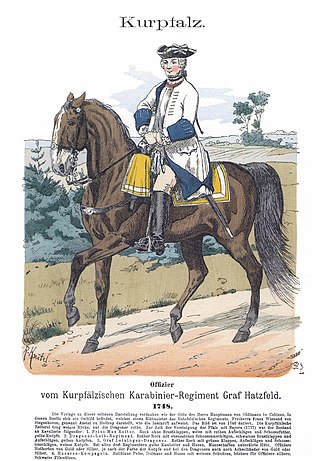Corporal is a military rank in use by the armed forces of many countries. It is also a police rank in some police services. The rank is usually the lowest ranking non-commissioned officer. In some militaries, the rank of corporal nominally corresponds to commanding a section or squad of soldiers.
Staff sergeant is a rank of non-commissioned officer used in the armed forces of many countries. It is also a police rank in some police services.
Feldwebel is a non-commissioned officer (NCO) rank in several countries. The rank originated in Germany, and is also used in Switzerland, Finland, Sweden, and Estonia. The rank has also been used in Russia, Austria-Hungary, occupied Serbia and Bulgaria.
Praporshchik is a rank used by the Russian Armed Forces and a number of former communist states. The rank is a non-commissioned officer's and is equivalent to Michman in the corresponding navies. It is usually equivalent to warrant officer class 1 or sergeant major in English-speaking armies. Within NATO forces, the rank is rated as OR-7 or OR-8.

Rittmaster is usually a commissioned officer military rank used in a few armies, usually equivalent to Captain. Historically it has been used Germany, Austria-Hungary, Scandinavia, and some other countries.
Commissioned officers' rank comparison chart of all land forces of NATO member states.
This page lists the enlisted ranks and insignia of NATO member armies. For the comparison chart of the commissioned officers, see Ranks and insignia of NATO armies officers.
The following are the ranks and insignia of NATO Air Forces Enlisted personnel for each member nation.
Each officer rank in the navy of a NATO country may be compared with the ranks used by any military service in other NATO countries, under a standardized NATO rank scale. This is useful, for instance, in establishing seniority amongst officers serving alongside each other within multinational command structures.
The following table lists the ranks and insignia of officers in NATO air forces.
This table shows the ranks and insignia of NCOs and Seaman in the navies of member countries of NATO. NATO maintains a "standard rank scale" in an attempt to match every member country's military rank to corresponding ranks used by the other members. The rank categories were established in the document STANAG 2116, formally titled NATO Codes for Grades of Military Personnel.
The People's Liberation Army (PLA) has not always used ranks or insignia. In common with the practice of the Red Army at the time of its founding in 1927, neither were used until 1955 when a system of ranks was established. As a result of the Cultural Revolution, ranks were abolished in May 1965. After the Sino-Vietnamese War of 1979, reforms in the PLA began to be made to professionalize the armed forces once more. The 1984 Military Service Law provided for the resumption of rank, but disagreements on what ranks were to be used and who would receive them caused the revival of rank to be delayed until 1988. The following ranks and their respective insignia shown are those used by the People's Liberation Army Ground Force.

The ranks and insignia used by Russian Ground Forces are inherited from the military ranks of the Soviet Union, although the insignia and uniform have been altered slightly.
The military ranks of Finland are the military insignia used by the Finnish Defence Forces. The ranks incorporate features from the Swedish, German, and Russian armed forces. In addition, the system has some typically Finnish characteristics that are mostly due to the personnel structure of the Finnish Defence Forces. The ranks have official names in Finnish and Swedish languages and official English translations. The Swedish forms are used in all Swedish-language communications in Finland, e.g. in Swedish-speaking units of the Finnish Defence Force. The system of ranks in the Swedish Armed Forces is slightly different.

The ranks in the Israel Defense Forces (IDF) reflect an individual's level in the military.

The military ranks of the Armed Forces of Ukraine (AFU) were established in March 1992, when Ukraine adopted the Law on Military Duty and Military Service 1992.
First sergeant is typically a senior non-commissioned officer rank, used in many countries.
This article deals with the rank insignia of the Austro-Hungarian Army, as worn by the Austro-Hungarian Army after the reorganisation in 1867 until 1918.



